Research Day, held during the afternoon of Thursday, July 31, at Lehigh University’s Mountaintop Campus, Building C, brought together students from various summer research groups across campus for a day of poster presentations, prize judging, and networking. Students in various undergraduate programs, including STEM-SI, the Marcon Institute, Natural Hazards Research Infrastructure (NHERI), Research Translation AcceLUrator, and Mountaintop Summer Experience programs prepared posters and presented short talks about their research during the 10-week programs: reading relevant literature, designing experiments, and interpreting results. The day ended with ice cream and an awards ceremony for the top-ranking posters as evaluated for research content, poster design, and presentation, plus a fan favorite award.
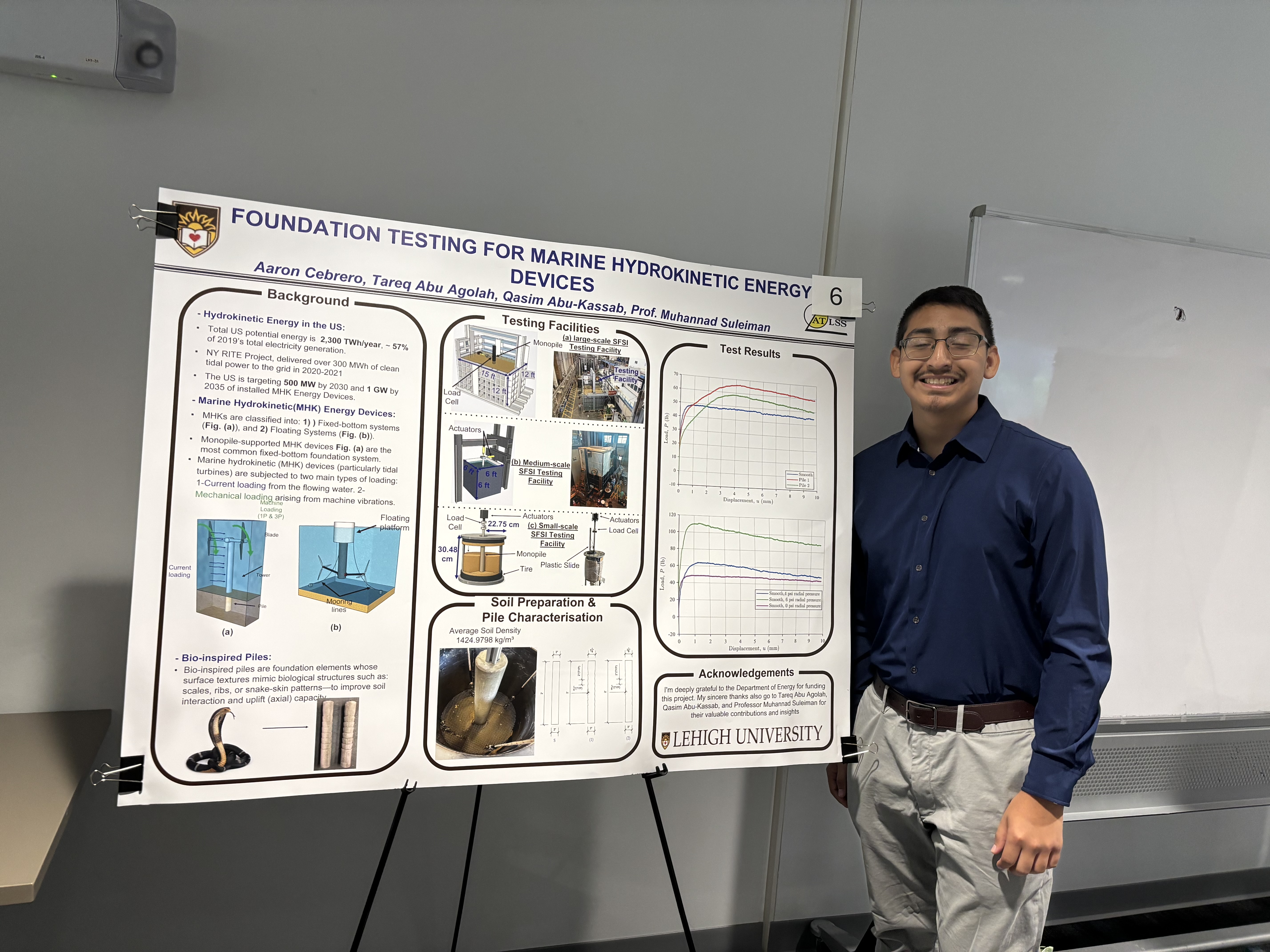
Aaron Cebrero researched offshore turbines as part of Muhannad Suleiman’s lab, working with graduate students Tareq Abu Agolah and Qasim Abu-Kassab. Suleiman, Professor of Civil and Environmental Engineering, researches offshore wind turbines; his research aims to capture more of the abundant wind energy off the coasts of the United States. In support of this, Aaron’s work this summer focused on bio-inspired surface designs for the cement piles in the underwater foundation of a fixed-bottom ocean turbine. He compared smooth pilings to two configurations of a pattern based on the scale arrangement of snakeskin to see which configuration held up best to the loads and stresses turbines will place on them in the ocean.
A rising sophomore at Lehigh, Aaron is contemplating enrolling in Lehigh’s 4+1 program for aerospace engineering, with a goal of working in industry or possibly at NASA. Initial issues with an attachment in a test setup taught him that “with research you have to try different things to get better results, and you have to go into it with an open mind.” That’s a lesson that will help him with all of his future research.
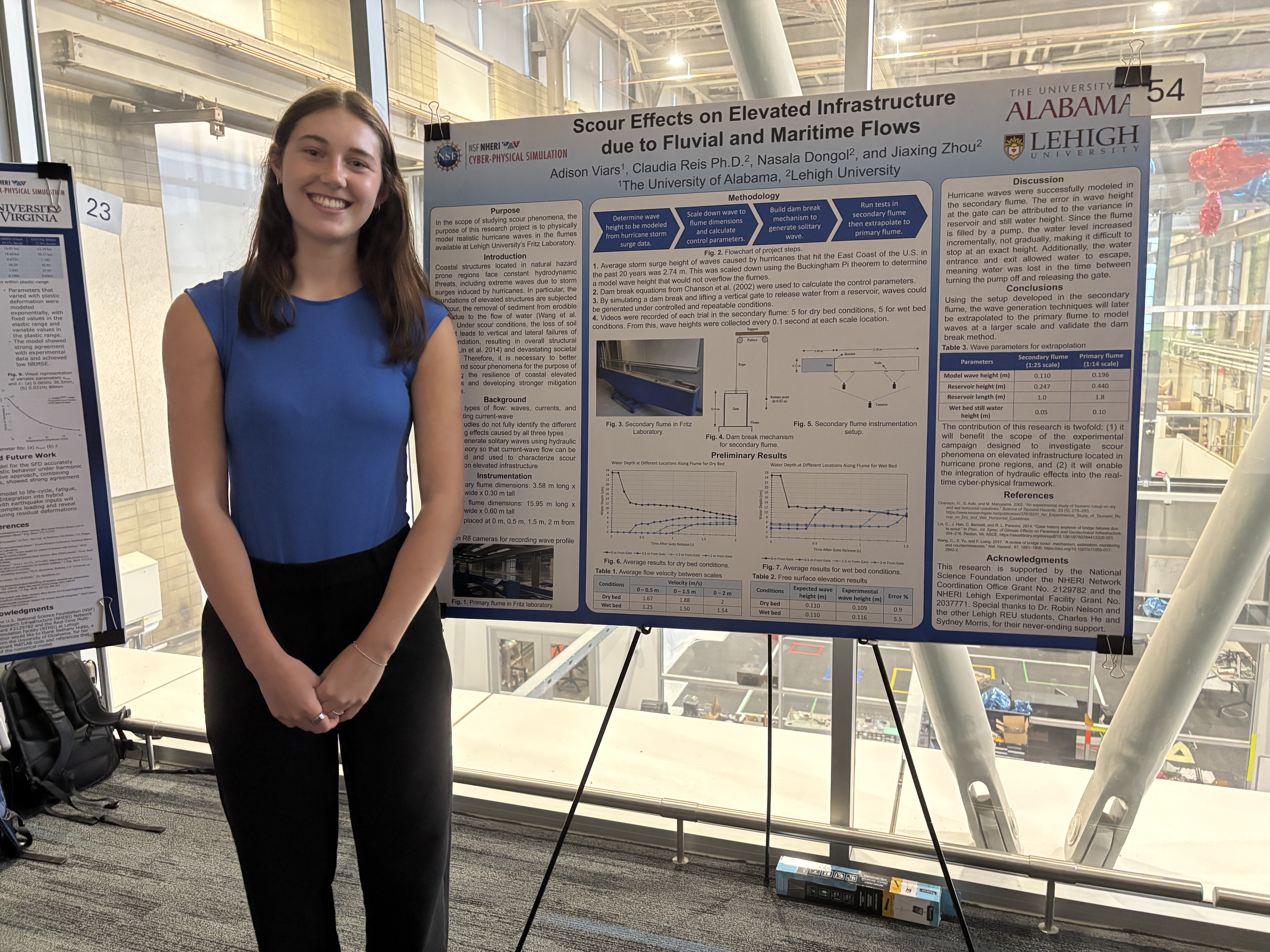
Adison Viars, a rising senior at the University of Alabama, was part of the NHERI REU program. She worked with Claudia Reis, Assistant Professor of Civil and Environmental Engineering, on the effects of scour on pilings. Scour, Adison says, is “basically erosion,” and her mission for the summer was to explore scour’s effects on pilings, the structural supports for buildings that extend into water, during extreme weather events. This research will contribute to improved designs for structures that experience scour.
Adison focused on dam failures under wet bed (with water present below the dam) and dry bed (no water) conditions, and she used water flumes in Fritz Laboratory for her testing. One of her first steps was to create a dam in the flume–and that’s where her project hit a snag. The original gate, or “dam,” that was supposed to hold the water in the reservoir tended to leak into the other side of the flume. This leakage prevented the flooding conditions she wanted to create for the experiment, so she added brackets on either side of the gate, waterproofed with Vaseline. This prevented the leakage, and Adison was able to test the height of waves under both wet and dry conditions and with various water flow rates. Adison recorded the flow with a series of cameras to measure the waves, then scaled that data to real-life conditions.
Adison is planning to attend graduate school then pursue a career in structural engineering. She says one thing that surprised her about the research she performed this summer was the amount of planning she needed to do before doing the actual experiments: “I thought I would get here and go straight into it, but I had to actually plan and do the lit reviews and find the best way to design things.”
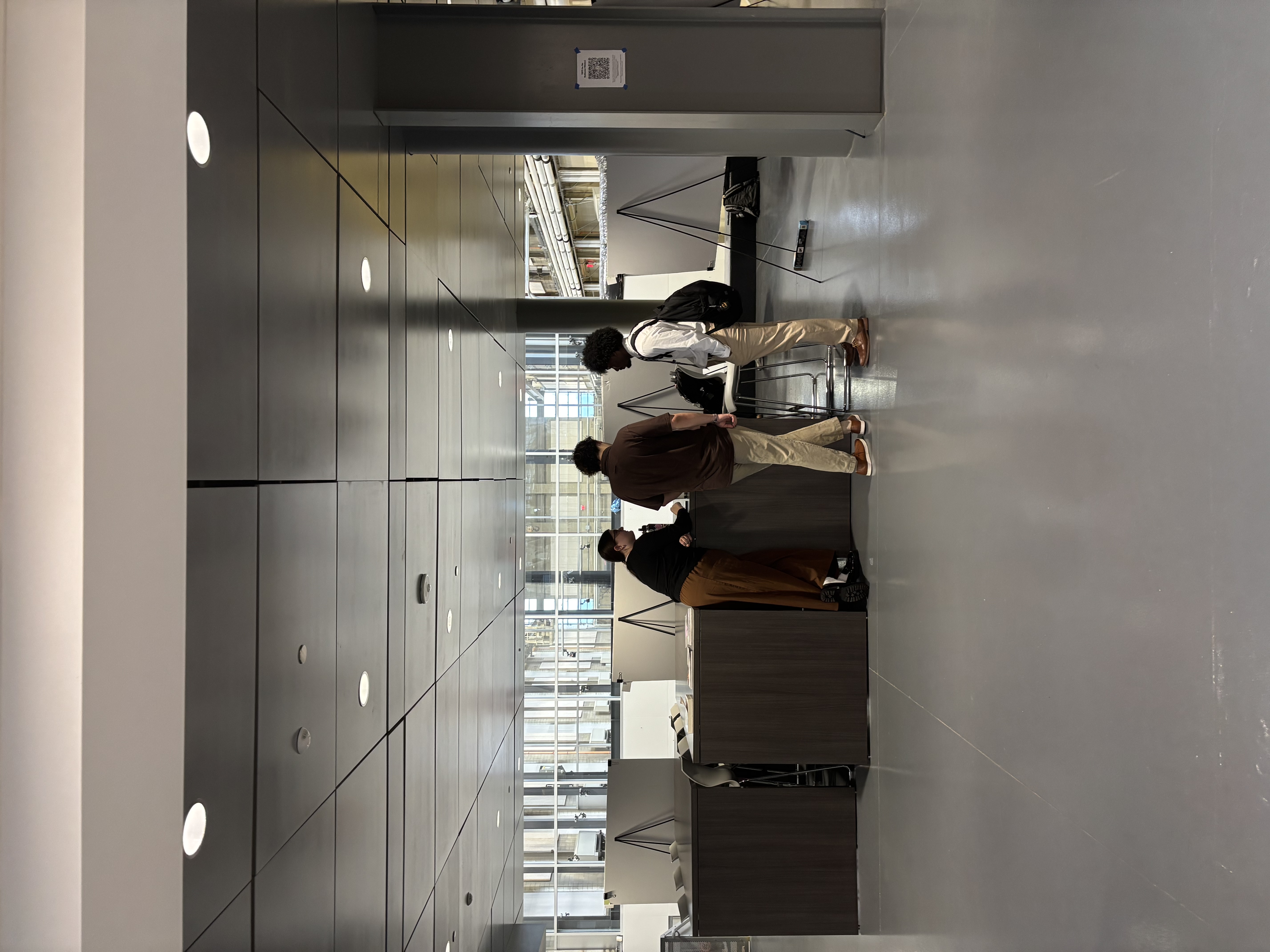
Research Day gives students an opportunity to find out about each others’ research–some even present their posters to each other, reinforcing the importance of communication across interests and disciplines. In fact, collaboration and networking are part of the day’s goals; as Institute for Cyber Physical Energy and Infrastructure (I-CPIE) operations manager Chad Kusko said on the REU’s opening day, the summer builds a “network of undergraduate researchers.”
A consistent theme among Research Day students was how supportive and valuable their lab mates and graduate student mentors were to not just their experiments, but also to their overall summer experience. In many cases, this was a permanent good-bye, but who knows? Someday the lab partners might find themselves together again in a lab or at a conference.
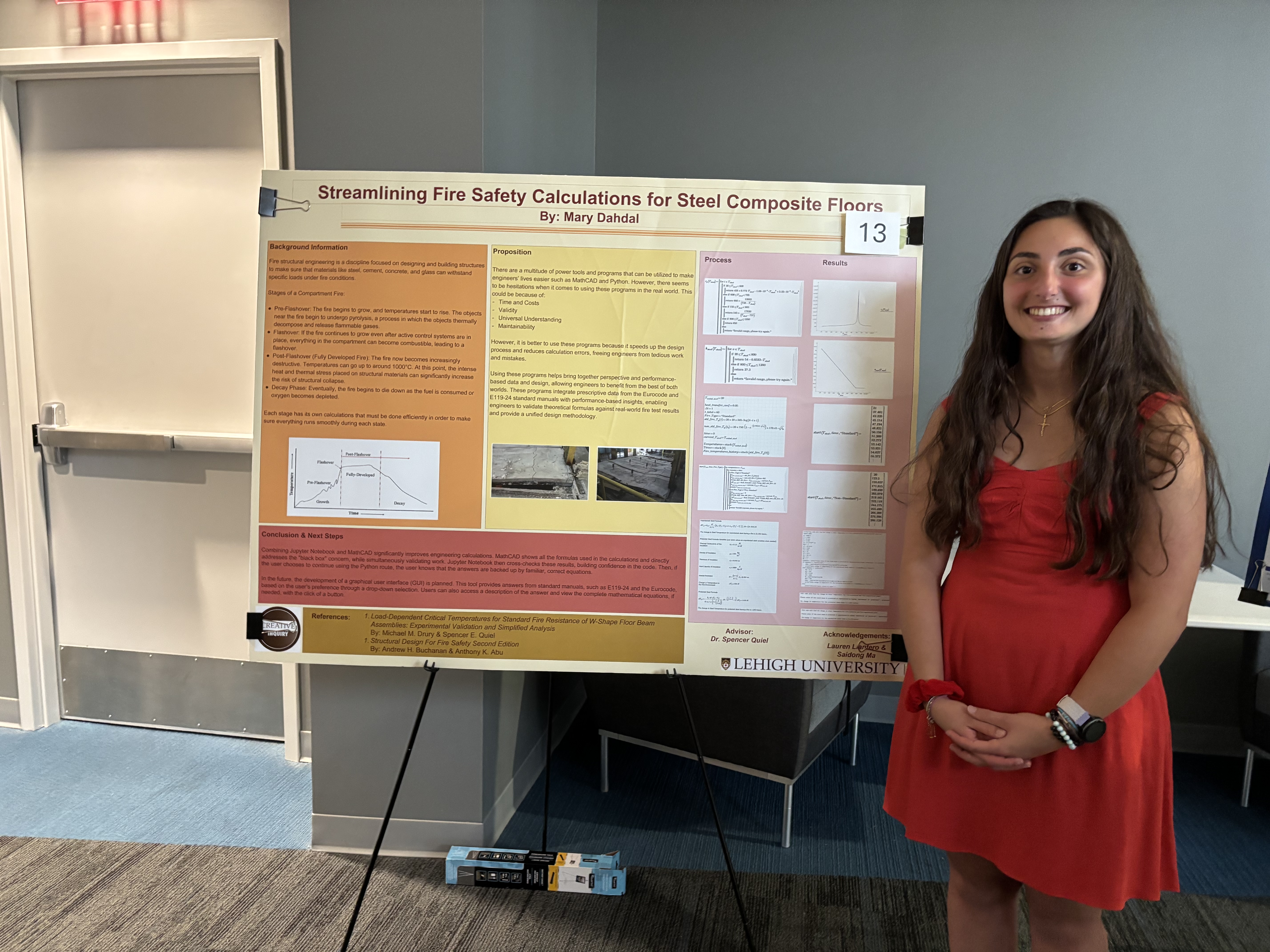
Even as a rising sophomore Lehigh University’s Mary Dahdal probably knows more about fire than most people, from the four stages of a compartment fire to how to computationally analyze the effects of a fire on materials and structures. Her summer research project, mentored by Spencer Quiel, Associate Professor of Structural Engineering, focused on developing a website for fire engineers that will help them perform the extreme number of calculations in the engineering calculations software Mathcad and Jupyter Notebook needed in their research.
During the summer, Mary realized that a few software programs she’d intended to rely on had limitations: for example, the version of Mathcad she was using couldn’t handle the unit designations she wanted to use. Demonstrating her resilience in research, she pivoted to using Google Collab and Gemini, which have the added bonus of being free and widely available. In one of the next stages of her research, she hopes to integrate an updated version of Mathcad to reintroduce the units.
Mary plans to become a structural engineer and is currently in the Lehigh 4+1 program in civil engineering. After she finishes her master’s degree, she’d like to return to her native Syria to help rebuild buildings bombed in the current conflict and to serve as a role model for young girls who want to become engineers.
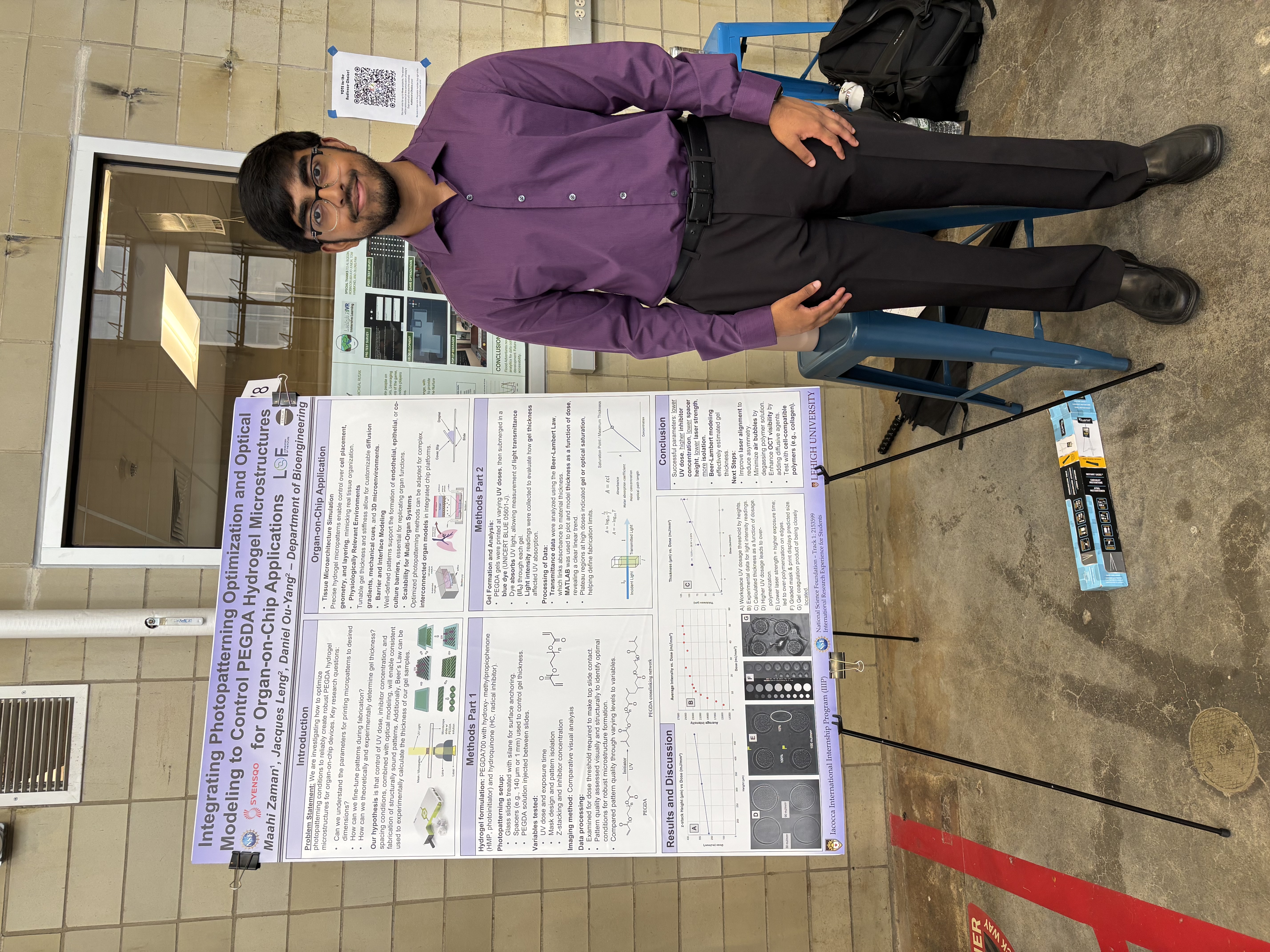
While most students worked on campus, Maahi Zaman, who will graduate in a semester from Lehigh’s 4+1 program, went big and traveled to Bordeaux, France–his first time traveling abroad. Working with his summer research mentor, Daniel Ou-Yang, Department of Bioengineering, on an internship with the Iacocca International Internship Program [https://global.lehigh.edu/internships], Maahi focused on optimizing photopatterning conditions to reliably create robust PEGDA (a biocompatible polymer) hydrogel microstructures for organ-on-chip devices–basically finding ways to optimize hydrogels so that they can be used in tissue-specific studies in human bodies.
In Bordeaux, he worked in the lab of Syensquo, which he says offered him insight into the difference between industry and academia in terms of work culture and funding. “It was my first time working in an industrial-style lab,” he says, and it gave him insight into funding that’s reliant on grants, where “a barrier is funding–if you’re trying to do a test, and you run out of a supply, your research stops.” In an industry lab, however, the money is there to keep the research going.
Maahi learned about resilience in research early on, as his premade polymer mix didn’t perform as expected during an initial modeling process. That forced a rethink to the overall approach. After he graduates, he hopes to work in industry, although he’s recently feeling a stronger pull toward research, so he won’t rule out the PhD.
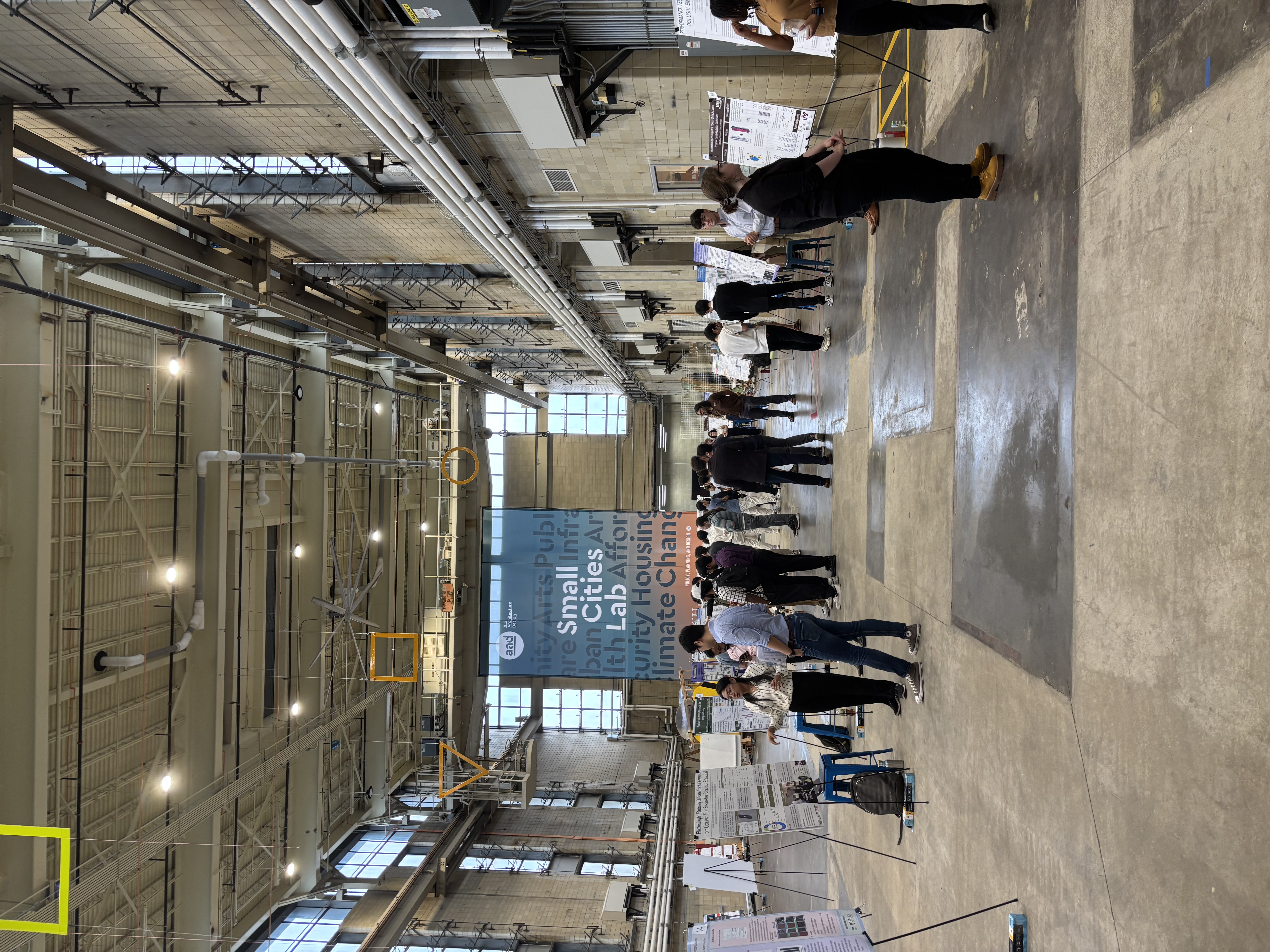
Building C’s Bay 2 hosts the largest number of posters of any room used for Research Day, and its vast space is filled with the sounds of people talking about research, hanging out on the steps, and getting sandwiches, snacks, and drinks. This year’s Research Day set a record for posters at 105, so the space to expand was welcome. Bay C provides visitors and presenters with room to spread out, and adds an industrial vibe from the days when the facility was owned by former industrial giant Bethlehem Steel–also a nod to the industrial facilities some students will work in during their engineering careers.
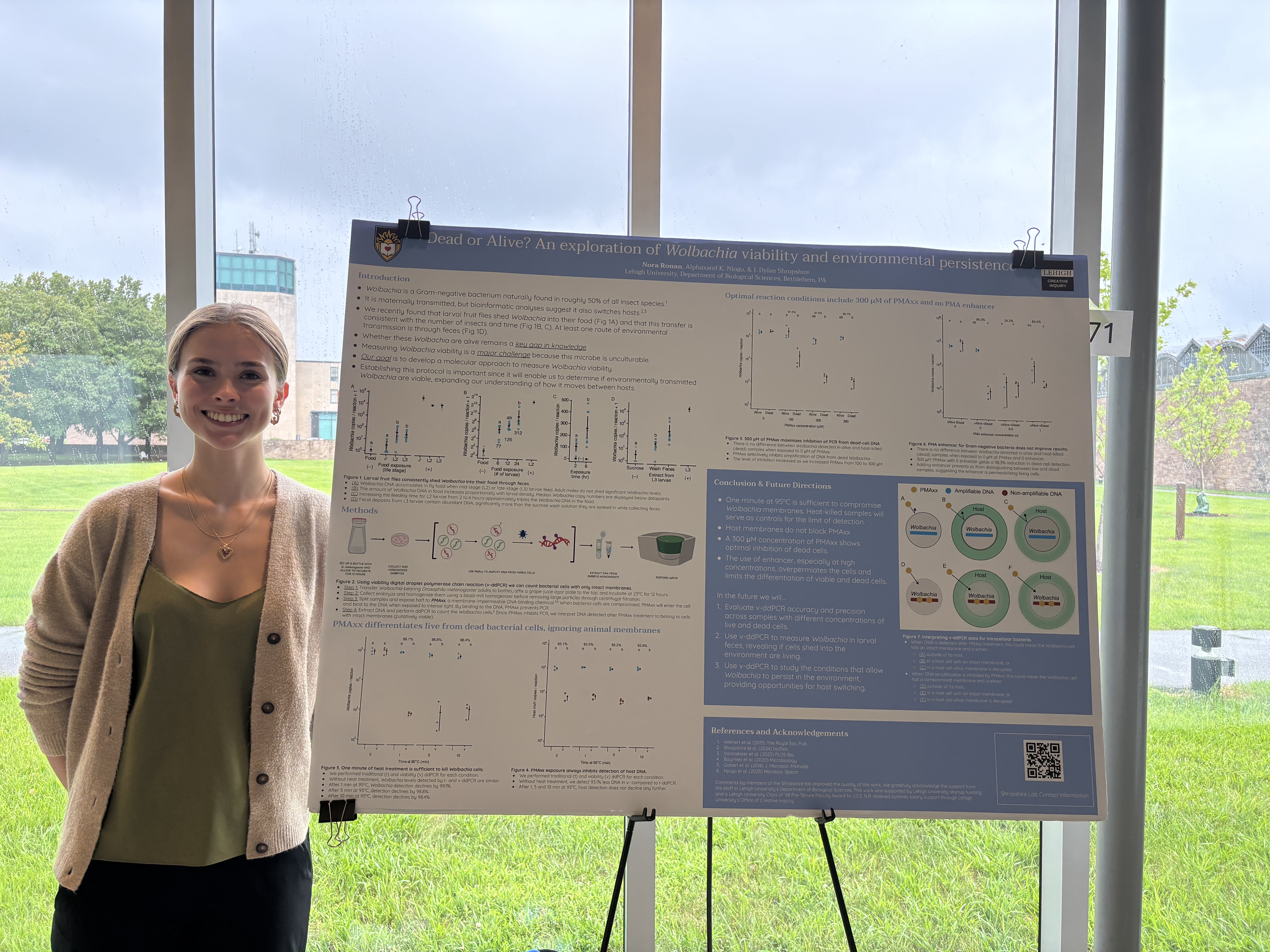
Rising senior Nora Ronan performed research in the Shropshire Lab at Lehigh, with graduate student mentor Alphaxand Njogu and Professor Dylan Shropshire, Assistant Professor of Biological Sciences. Shropshire’s ongoing research focuses on the Wolbachia bacteria, an endosymbiont (it lives within its host, mosquitos) that could be instrumental in the fight against mosquito-borne diseases, such as dengue fever, which kill more than a million people a year worldwide. Wolbachia are unculturable, so it’s hard to determine if they are alive in a sample, which in turn makes it hard to determine how they move from host to host. Understanding how Wolbachia spread can help researchers slow the spread of disease.
Nora’s goal was to develop an approach to measuring Wolbachia viability. Her research hit a few bumps over the summer: a strain of bacteria that wasn’t supposed to have Wolbachia did have it, forcing a direction change.
For Nora, though, that’s part of the process that she’s learned in the lab: “It’s not really discouraging when you get a bad result. It’s, okay, we got a bad result, how are we going to think to combat this problem? What could have possibly gone wrong? Is it a pipetting error or is it something bigger than that? I think things like that are so vital and that’s probably what I’ll take away from this summer.”
She’s gearing up to apply to doctoral programs, a stressful experience for everyone. But she should be buoyed by her research’s mission. As Nora says, “it can get frustrating when your experiment fails. But there’s constantly this implication that even if my experiment fails on one day, any good results that I get could literally change the world.”
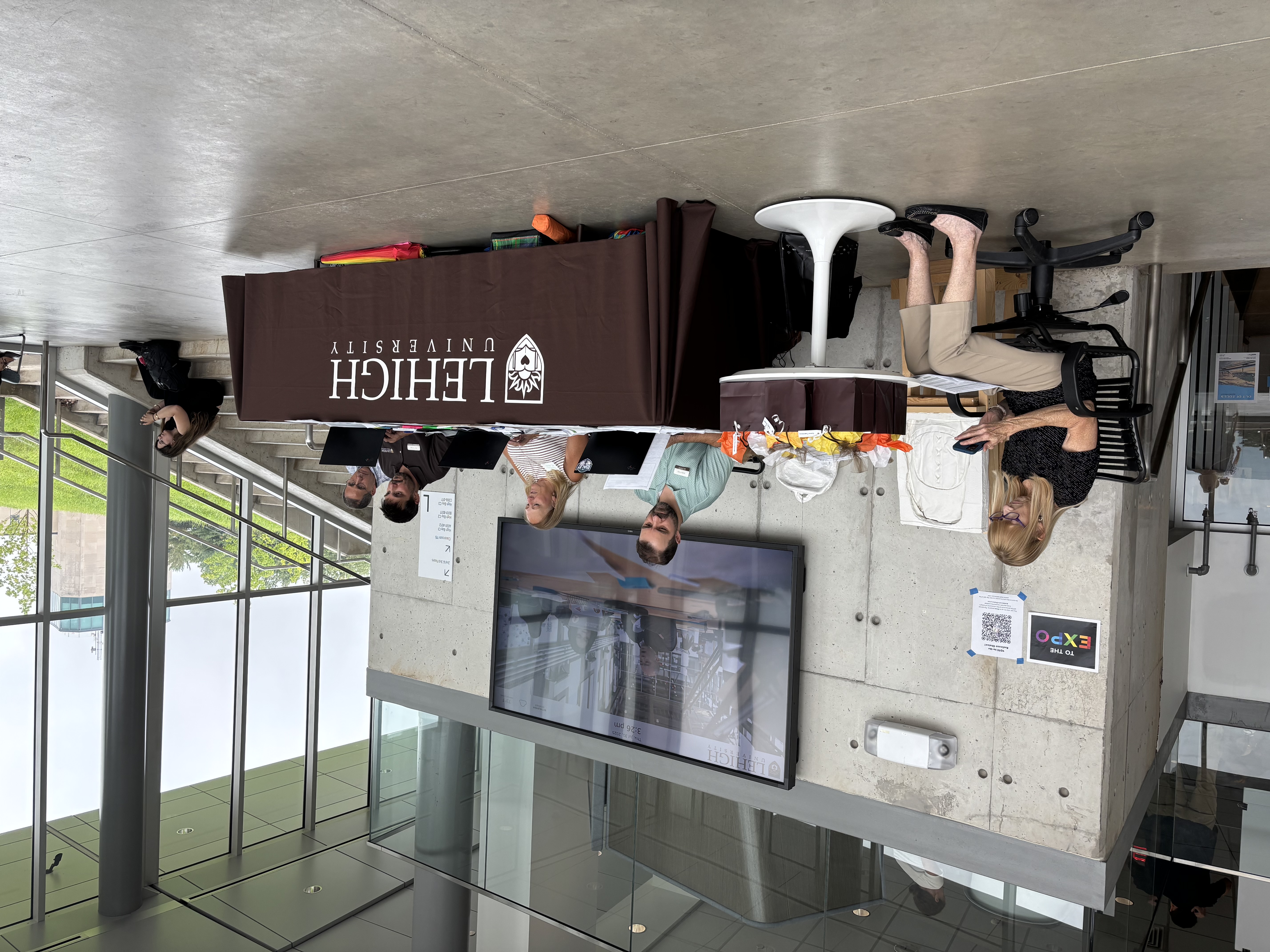
After the judges filled in their scoring rubics, they handed the sheets to the staff to be tabulated. Time was tight: while students enjoyed ice cream in Bay C, Christine McNeill, Development Associate, Development and Alumni Relations; Kyle Scroggs, Associate Director of Development, College of Arts and Sciences; Ruby Scott, Coordinator, I-CPIE; and others averaged scores and ranked them to find out who won in each category. Such efforts epitomize STEM-SI and all the summer research programs at Lehigh University: thoughtful, engaged support of the students to allow them to reach their goals.
Topping each prize category were:
Research
1. Jeremiah Akalu; mentor Javad Khazaei, Electrical and Computer Engineering; “Machine Learning Algorithms for Fault Detection in Electricity Grids”
2 (tie). Prashant Panta and Ayoola Shomotun; mentor Rosa Zheng, Electrical and Computer Engineering; “Research and Development of Underwater Vehicles”
2 (tie). Andrew Wu, Samiha Islam, Gisel Govea, and Colby Snatchko; mentor Neal Simon, Biological Sciences; “NfL as a Biomarker of Mild Traumatic Brain Injury Severity: Effects of V1aR Antagonists”
Poster Design
1 (tie). Nafisa Tasnim; mentors Zheng Yao and Carlos Romero, Mechanical Engineering and Mechanics: "Electrodialytic Recovery of Rare Earth Elements from Coal Ash for Sustainable Resource Extraction"
1 (tie). Tyler Gruver; mentor Wynn Meyer, Biology; “Automating Methods for Correlating Genes and Diet”
1 (tie). Nikolas Cruz; mentor Ariel Sommer, Physics; “Enhancing Experimental Reproducibility Through Line-Synchronized Triggering”
2. Swetcha Reddy Tukkani, Joe Capuno, and Jack Filius; mentor Jong Cheol Shin, College of Health; “Enhancing Walkability at Lehigh University”
Oral Presentation
1 (tie). Omar Aly, Grace-lilie Acheampong, and Aidan Arnold; mentor Srinivas Rangarajan, Chemical and Biomolecular Engineering; “STEM Visualizations: Bayesian Optimization”
1 (tie). Phillip Rotzell; mentor Cristabella Fortna, Chemistry; “Ab Initio Modeling of Nanoparticle Titanium Oxide Surfaces for Carbon Dioxide Reduction Mechanisms”
1 (tie). John Palacios; mentor Rosi Reed, Physics; “Measuring dNch/dEta for P-P and Au-Au Collisions Using the sEPD”
1 (tie). Asha Marwaha, Chase Kusko, and Devon Sutton; mentor Neal Simon, Biological Sciences; “Circadian Activity Cycles Following Traumatic Brain Injury: Pilot Studies”
Fan Favorite
Nora Roman; mentor Dylan Shropshire, Biological Sciences; “Dead or Alive? The Exploration of Wolbachia Viability and Environmental Persistence”
